 Do you want your Algebra 1 students to remember how to factor when they get to Algebra 2? What about students taking the IGCSE test at the end of a two-year program? Practice and drill may help, they serve a purpose to that end, certainly. But recall is more reconstruction of ideas than memorization. To get them to remember how to factor, they'll have to first really understand what factoring is. This lesson is designed to promote recall through strengthening understanding by challenging what they think and causing some cognitive dissonance.
Do you want your Algebra 1 students to remember how to factor when they get to Algebra 2? What about students taking the IGCSE test at the end of a two-year program? Practice and drill may help, they serve a purpose to that end, certainly. But recall is more reconstruction of ideas than memorization. To get them to remember how to factor, they'll have to first really understand what factoring is. This lesson is designed to promote recall through strengthening understanding by challenging what they think and causing some cognitive dissonance.
If this sounds like what you're looking for, download the PPT here, and read on. (Print a copy of the powerpoint with notes for your own use.) Be warned, execution on your part is critical. You role in this lesson is as a facilitator, translator, and guide, not as a judge or resident expert. Do not confirm or deny answers because to do so will stop their thinking and this lesson is not about procedure. Your job is to be aware of what your students are saying and thinking and to encourage them to remain engaged and on task. Classroom management and the ability of students to conduct a whole-class conversation in ways that promote understanding and encourage participation (where wrong answers aren't embarrassing) are of the highest order of importance.
Last thing before we get into the lesson: Do not tell them they're learning about factoring and distributing because you cannot tell them on the test and you won't be there to tell them next year! The idea is for them to know the math because of how it is written, not because of a clue they get from you or somewhere else. We are promoting math fluency here in order to improve retention and promote deeper understanding.
Objective: Promote deeper understanding of factoring, recall and promote mathematical fluency.
Introduction: Because of the purpose of the lesson and the method of fulfilling the purpose, it is beneficial to spend a few moments discussing the following with them.
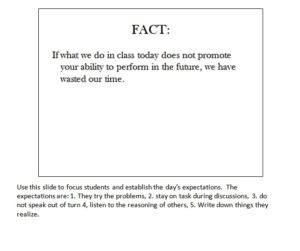
The first question should not take very long. It might be good to have them spend a minute or so working quietly, but with this problem do not allow them to discuss together. The discussion that best helps students articulate the math concepts at play here is best done as a whole-class discussion. (We don't want students just going along with the opinion of other students based on a perceived mathematical authority.)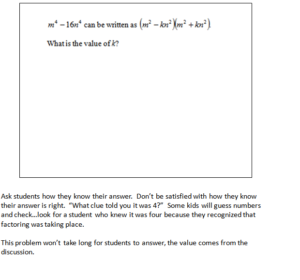
After they've worked for a brief time, ask students how they go the answer. Do not accept that the "4" just came to them, or that how they verified it was right. You're looking for them to articulate that they recognized that one form was factored of the other and that factoring does not change the value. Many students will find the answer by plugging in numbers without making the connection to factoring.
After this slide you may want to show them the slide with the Japanese notes again (slide 3) and discuss how students can copy every shape down, and some shapes they think are understood, but likely are not. Without the ability to read, it's memorization without understanding.
For the second problem many students will be suspicious of a trick. They'll use their experiences as a student as a clue to "perform more math." But again, this activity is NOT about getting the answer. We want them to justify why they know one answer is right and the others are wrong. Both parts are equally important.
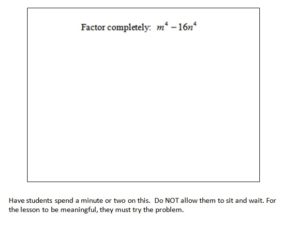 After a few minutes, show the next slide, and this one will likely time a bit of time. Facilitate discussion here. Do a poll on who thinks which is right. Then, when a kid, say Bob, says A is the answer, ask him if he think A and the problem are equal. Ask a kid who does not think A is the right answer if he thinks A and the original problem are equal. Do NOT confirm anything. Ask someone why they do not believe A is the answer.
After a few minutes, show the next slide, and this one will likely time a bit of time. Facilitate discussion here. Do a poll on who thinks which is right. Then, when a kid, say Bob, says A is the answer, ask him if he think A and the problem are equal. Ask a kid who does not think A is the right answer if he thinks A and the original problem are equal. Do NOT confirm anything. Ask someone why they do not believe A is the answer.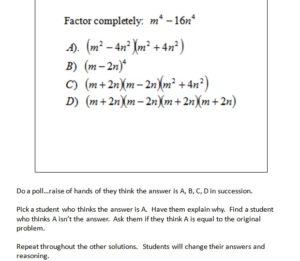
Work similarly through the other solutions. You'll find that kids won't pick an answer at first, like B, but then they'll switch their answers and reasoning. Explain this cognitive dissonance is when they have realized that something they thought they understood, or something they believed was true, is no longer understood or true, and they uncomfortable feeling is them looking to replace that security found in assurance. It's an integral part of learning. Learning does NOT occur with out that experience.
Once all are in agreement with C being the answer and why (and others are wrong) ask them what they've learned. Ask them to write that down. Make sure that they come up with the "the sum of squares is NOT factorable but the difference is," and why.
It's a good idea to again discuss the cognitive side of what the students are experiencing. Make them think about their thinking. After a short discussion about meta-cognition and learning, have them discuss and record their observations. This is outlined in the PowerPoint.
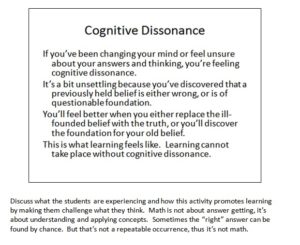
The last slide could be homework or another in-class activity. The thing for them to recognize here is the nature of a perfect square...used in completing the square ... half of "b" squared is "c" referring to the standard for coefficients. To tell them what it is they're supposed to notice steals, from them, an opportunity to learn! These connections are what they're practicing making.
And again, this is NOT an answer getting activity. This is about challenging understanding. Kids can have the right answer but the wrong understanding, or incomplete understanding. We want deep understanding because that will promote retention.
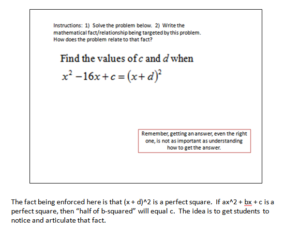 Try the lesson as an end-of-quarter review, or a unit test review. Let me know how it went. Leave me a comment or ask a question at [email protected].
Try the lesson as an end-of-quarter review, or a unit test review. Let me know how it went. Leave me a comment or ask a question at [email protected].
Thanks again.




